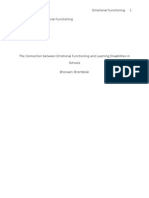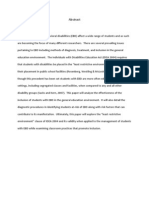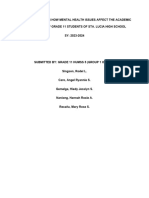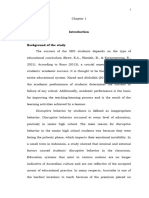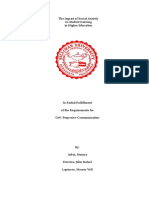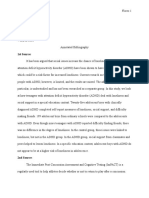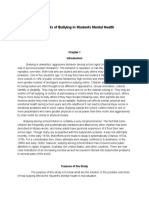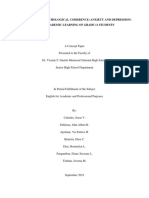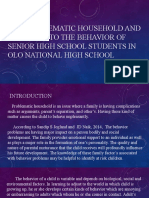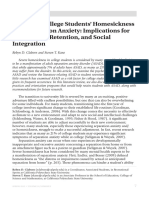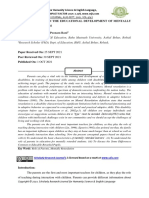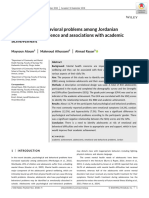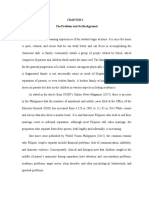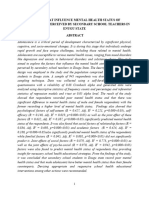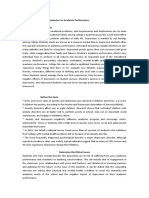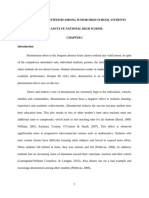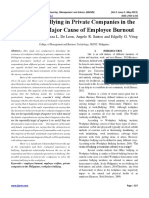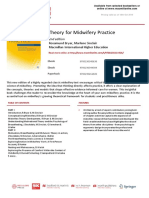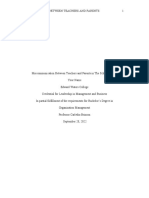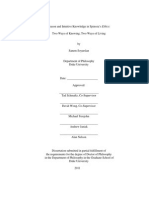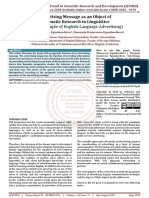Social Research Essay
Social Research Essay
Uploaded by
DiannaCopyright:
Available Formats
Social Research Essay
Social Research Essay
Uploaded by
DiannaOriginal Description:
Copyright
Available Formats
Share this document
Did you find this document useful?
Is this content inappropriate?
Copyright:
Available Formats
Social Research Essay
Social Research Essay
Uploaded by
DiannaCopyright:
Available Formats
BEHAVIOR AND EMOTIONAL ISSUES IN EDUCATION: A SOCIAL RESEARCH
ESSAY
Behavior and Emotional Issues in Education: A Social Research Essay
Dianna Smith
Brandman University
Author Note
This paper was prepared for LBSU 487 Applied Studies Capstone
taught by
Melanie Borrego, December, 3, 2016
1. Introduction
Majority of mental health disorders begin during childhood or adolescence,
but may be undiagnosed and untreated if not detected at an early stage. Mental illness
BEHAVIOR AND EMOTIONAL ISSUES IN EDUCATION: A SOCIAL RESEARCH
ESSAY
is an umbrella term for a clinically recognizable set of symptoms or behaviors with
specific characteristics and treatment (Moss, 2012). It disrupts a persons thinking,
emotions, and ability to function on a daily basis. Mental Health Statistics (2010)
suggests that in 2010, 1 in 10 youth in the US experience a severe mental issue that
limits daily living.
Students are vulnerable to mental health and emotional problems yet remain
unnoticed in general education classrooms. It is even more difficult to assess if a
student with learning disability has mental or emotional issues because it can be lost
among other behaviors they exhibit. Children and youth exhibiting challenging
behaviors contributed by emotional issues may qualify to receive services as stated in
the Individuals with Disabilities Education Act (IDEA), the countrys law that protects
students with disabilities. IDEA uses the term emotional disturbance (ED) to refer to
challenging conditions that adversely affects a childs educational performance
("Emotional Disturbance", 2010). These conditions may include the inability to learn
that cannot be explained by intellectual factors, the inability to build or maintain
interpersonal relationships, inappropriate behavior or feelings under normal
circumstances, general pervasive mood of unhappiness or depression, and the
tendency to develop fears associated with personal problems.
As a result of the display of behaviors that hinder their development, students
with emotional disorders exhibit poorer academic performance. They are more likely
to earn lower grades, fail more courses, and have more difficulty in adjusting to adult
life than students with other disabilities (Landrum, Tankersley, & Kauffman, 2003).
The aim of this study is to highlight the the challenges associated with
education and treatment of students with ED and evaluate the practices implemented
in special education to support the development of students with ED.
BEHAVIOR AND EMOTIONAL ISSUES IN EDUCATION: A SOCIAL RESEARCH
ESSAY
2. Literature Review
2.1 Characteristics
Students with emotional disturbance are a heterogenous group of young
people with a wide range of issues unique to each individual (Students with
Emotional Disturbance", 2001; "Emotional Disturbance", 2010; "Emotional
Disorders", 2013). In order for a condition to be considered an emotional disorder, it
must occur for an extended period of time and must have negative impact on students
academic performance with no intellectual cause of difficulty. Signs of physical
aggression and self-injurious behavior are usually present ("Emotional Disturbance",
2010). Prevalence of such behaviors do not automatically qualify a student to be
eligible for special education services. Student must meet the requirements as set by
IDEA and local school districts based on specific criteria and standards ("Students
with Emotional Disturbance", 2001).
Students with ED typically exhibit individual characteristics unique from each
other (Students with Emotional Disturbance", 2001; "Emotional Disturbance",
2010). These may include mood disorders, anxiety disorders, ADHD, psychiatric
disorders, or schizophrenia. Behavioral problems may be intensified as a result of cooccurrence of emotional disturbance and other disabilities. The Center for Effective
Collaboration and Practice (2001) highlights that ED students are more likely to live
with one parent, or in foster care. They are also vulnerable to environmental chances
such as lack of positive support in transitions. Mental Health Statistics (2010) also
indicate that ED students are 2x as likely as other students with learning handicaps to
live in a correctional facility or drug treatment center. 85% of children in juvenile
facilities have learning disabilities that qualify them for special education services, yet
BEHAVIOR AND EMOTIONAL ISSUES IN EDUCATION: A SOCIAL RESEARCH
ESSAY
only 37% have been receiving such kind of services ("Mental Health Statistics",
2010). All these characteristics inhibit a negative association of ED students with their
academic performance and disability-related behavior.
Children with ED, in comparison with children with or without disabilities, are
more likely to be male, African American, and economically disadvantaged
("Students with Emotional Disturbance", 2001). In 1987, more than 30% of students
with ED are from households with income less than $12,000 and 44% came from
single-parent households (Wagner, 1995). Evidence suggests that significant
economic disadvantage and notable family stressors may contribute to the childs
emotional disorder (Wagner, 1995).
In Lee & Jonson-Reids study (2009), the longitudinal analysis shows that
despite the high rates of service received by ED students, they are still more likely to
experience a negative outcome, such as poor academic performance, emergency room
treatment, juvenile delinquency and other mental problems. Among students
diagnosed with ED, children with child welfare contact had higher rates of poor
outcomes along with those parents who had not graduated from high school.
2.3 Learning impacts and other outcomes
Students with ED have a low average intelligence, and are more likely to
experience less school success than children with or without disabilities. Research
("Mental Health Statistics", 2010) suggests that students with ED have the worst
graduation rate among students with disabilities. Compared to the national average of
graduation rate of 76%, only 40% of ED students graduate from high school.
Landrum, Tankersley, & Kauffman (2003) claim that students with ED have
lower grades, fail in more courses, retain in grade more often, pass minimum
BEHAVIOR AND EMOTIONAL ISSUES IN EDUCATION: A SOCIAL RESEARCH
ESSAY
competency tests at lower rates, and have more difficulty adjusting to adult life than
other students with handicaps. 43% of students with ED also drop out of school and
have lower outcomes in terms of improving school attendance.
Rutter (1974) evaluates the correlation of emotional disorder and educational
underachievement. Children with educational underachievement usually suffer from
additional handicaps, such as learning and emotional disorders. In his study,
underachievement is measured in terms of expected scholastic progress, IQ and/or
metal age. He performed a qualitative analysis examining various mechanisms
associating underachievement with other disorders. He suggests that emotional factors
play a greater part in academic difficulties. It could be due to anxiety, stress, lack of
motivation, avoidance of learning, temperamental features, and impaired function.
Wagner (1995) performs a longitudinal study on young people with ED and
describes high school perfomance, social experiences, postsecondary education and
labor market participation, and residential independence. These are used to analyze
what contributes to poor outcomes and performance of youth transitioning from
secondary school to early adulthoood. Her research suggests that academic
performance are generally poorer for ED students, with their GPA 0.2 lower than the
average of special education courses. 74% of students who took mainstreaming
classes failed one or more of them, and more than half who left high school left
without a diploma.
Margraf & Pinquart (2015) examine that adolescents with ED have lower
expectations regarding transition to adulthood, such as moving out of parents home,
finishing postsecondary education, being employed, getting maried, and becoming
parents, than adolescents without ED. They are also more likely to experience such
transitions at a later age, while some anticipate remaining unmarried.
BEHAVIOR AND EMOTIONAL ISSUES IN EDUCATION: A SOCIAL RESEARCH
ESSAY
Overall, these negative impacts and outcomes associated with ED students are
just part of a bigger problem of people with underlying mental health issues.
2.4 Interventions and strategies
Despite the challenges associated with education and treatment of student with
ED, there are available teaching strategies and interventions that could address the
negative outcomes associated with ED students.
Landrum, Tankersley, & Kauffman (2003) evaluate the various interventions
and effective practices for inappropriate behavior. The study suggests that in order for
an intervention to succeed, it must be built on a behavioral foundation. The model
usually implies that an environment cues occurrence of behavior, then the behavior
occurs, and finally the consequence ensues. This allows two points of intervention,
whether on prior to behavior occasion or after the behavior occurs. Noncompliance is
one of the most frequently demonstrated behavior by ED students, and altering
antecedents could increase the probability of students of complying. Altering
consequences, on the other hand, have the opportunity to increase or decrease
reinforcement of behavior.
Wagner (1995) believes parent involvement, placement and vocational
opportunities, and social integration could encourage ED students to achieve positive
outcomes. The study suggests that involvement of family members encourage
students to have higher expectations and motivate learning. Students with supporting
parents are 24% less likely to fail in class and are esitmated to miss fewer days of
school per year. It is also important to provide opportunities for placement and
vocational education to encourage academic goals for ED students. It improves their
chances of achieving compettive employment after graduating from high school.
BEHAVIOR AND EMOTIONAL ISSUES IN EDUCATION: A SOCIAL RESEARCH
ESSAY
Texas Council for Developmental Disabilities (2013) suggests that wraparound
planning is a great collaborative process to support students with ED. The planning
involves all collaborators (i.e. teacher, paretns, mental health clinicians, social worker,
guidance counselor, etc.) to create a support system based on the students individual
strengths. Family involvement is integral to this model to reinforce the community
support. Moreover, teachers must provide a classroom task that is less likely to result
in a behavioral outburst. It is important to be consistent in applying praises and
consequences, and to build trust with ED students.
3. Discussion and Conclusion
Children who display emotional disturbances may have behavioral issues at
various times during their development and may occur over long periods of time.
They may be eligible to receive support and services based on their individual needs,
and it is important to keep an open communication between the child, the parents, and
the collaborators involved.
As evidence suggests, poor academic achievement is one of the prevalent
effects of emotional disturbances. While research suggests this negative relationship,
it is vital to not make any assumptions about a child with emotional disorder and their
school performance. It is important to have a strong foundation of trust and mutual
respect reinforced by a positive behavioral intervention in order to have a lasting
impact on the emotional development of the child.
There are numerous organizations available to help support classroom
intervention for students with ED, particularly school district special education
programs and assistance. Also, there are a number of assistive technology devices for
individuals who are emotionally disturbed. Some of these technology may include a
BEHAVIOR AND EMOTIONAL ISSUES IN EDUCATION: A SOCIAL RESEARCH
ESSAY
behavior reinforcement chart to visually track changes in behavior, iPads, Chrome
books, Wii, online academic games, and Classroom Dojo.
BEHAVIOR AND EMOTIONAL ISSUES IN EDUCATION: A SOCIAL RESEARCH
ESSAY
4. References
Emotional Disorders. (2013). Texas Council for Developmental Disabilities.
Retrieved 2 December 2016, from
http://www.projectidealonline.org/v/emotional-disturbance/
Emotional Disturbance. (2010). Center for Parent and Information Resources.
Retrieved 2 December 2016, from http://www.parentcenterhub.org/wpcontent/uploads/repo_items/fs5.pdf
Landrum, T., Tankersley, M., & Kauffman, J. (2003). What is special about special
education for students with emotional or behavioral Disorders?. The Journal
Of Special Education, 37(3), 148-156.
http://dx.doi.org/10.1177/00224669030370030401
Lee, M. & Jonson-Reid, M. (2009). Needs and outcomes for low income youth in
special education: Variations by emotional disturbance diagnosis and child
welfare contact. Children And Youth Services Review, 31(7), 722-731.
http://dx.doi.org/10.1016/j.childyouth.2009.01.005
Margraf, H. & Pinquart, M. (2015). Do adolescents with emotional and behavioral
disturbances attending schools for special education have lower expectations
regarding the transition to adulthood?. European Journal Of Psychology Of
Education, 31(3), 385-399. http://dx.doi.org/10.1007/s10212-015-0268-3
Mental Health Statistics. (2010). Institute on Disability. Retrieved 1 December 2016,
from http://www.whocaresaboutkelsey.com/the-issues/statistics
Moss, S. (2012). Mental health problems in people with learning disabilities.
Challenging Behaviour Foundation. Retrieved 2 December 2016, from
http://www.challengingbehaviour.org.uk/learning-disability-files/12_mentalhealth-problem-in-PWLD.pdf
BEHAVIOR AND EMOTIONAL ISSUES IN EDUCATION: A SOCIAL RESEARCH
ESSAY
10
Rutter, M. (1974). Emotional disorder and educational underachievement. Archives
Of Disease In Childhood, 49(4), 249-256.
http://dx.doi.org/10.1136/adc.49.4.249
Students with Emotional Disturbance. (2001). Center for Effective Collaboration and
Practice. Retrieved 2 December 2016, from
http://cecp.air.org/resources/20th/intro.asp
Wagner, M. (1995). Outcomes for Youths with Serious Emotional Disturbance in
Secondary School and Early Adulthood. The Future Of Children, 5(2), 90.
http://dx.doi.org/10.2307/1602359
You might also like
- Chapter 3Document7 pagesChapter 3Lovely DelaTorre100% (9)
- Case Studies CHP 2 & 3Document9 pagesCase Studies CHP 2 & 3meaowNo ratings yet
- Research ProposalDocument39 pagesResearch ProposalVERNA GARCHITORENANo ratings yet
- Review Journal Articles FinalDocument6 pagesReview Journal Articles FinalLeo PilayanNo ratings yet
- Alejandre, S - Comprehensive Group Curriculum-Foster YouthDocument47 pagesAlejandre, S - Comprehensive Group Curriculum-Foster Youthapi-283084331100% (1)
- Empower@Work Collaborative Practitioner GuideDocument26 pagesEmpower@Work Collaborative Practitioner GuideTunggalNo ratings yet
- Schools of Management ThoughtDocument20 pagesSchools of Management Thoughtatiq_iuk75% (4)
- Case Study On DepressionDocument10 pagesCase Study On DepressionKedar DahalNo ratings yet
- Emotional and Behavioral Problems of Children With Learning DisabilitiesDocument10 pagesEmotional and Behavioral Problems of Children With Learning DisabilitiesGeorgiana CretuNo ratings yet
- Chap 2Document5 pagesChap 2velascofaithricarose17No ratings yet
- Chapter I Kimjoy Adami Research PaperDocument9 pagesChapter I Kimjoy Adami Research Papervelascofaithricarose17No ratings yet
- Learning DisabilitiesDocument21 pagesLearning DisabilitiesBronwen Johnston-StrembiskiNo ratings yet
- Assessment: Group Camacho-Ignacio (Salcedo) "Unspeakable Mental Health of INNHS Grade 12 Students Within Their Families: A Qualitative Research"Document3 pagesAssessment: Group Camacho-Ignacio (Salcedo) "Unspeakable Mental Health of INNHS Grade 12 Students Within Their Families: A Qualitative Research"John Rotrix TumanengNo ratings yet
- EBD Research PaperDocument11 pagesEBD Research Paperbomboy7100% (1)
- Research (CHAPTER 1)Document10 pagesResearch (CHAPTER 1)Hannah Roxie NaniongNo ratings yet
- Quantative Research: Disruptive Behavior and Academic Performance of SHS StudentsDocument40 pagesQuantative Research: Disruptive Behavior and Academic Performance of SHS Studentsearlgerald.cabilanNo ratings yet
- Learning Disabilities 1: Plagiarism Report - 4%Document13 pagesLearning Disabilities 1: Plagiarism Report - 4%Manvi BhargavNo ratings yet
- Social Anxiety ResearchDocument21 pagesSocial Anxiety ResearchJohn DoroteoNo ratings yet
- Bulatao, Tiffany Amber P. - Chapter IiDocument9 pagesBulatao, Tiffany Amber P. - Chapter IiTiffanyAmberNo ratings yet
- Related LitDocument13 pagesRelated Litapi-3502424160% (1)
- Group 2 Chapter 1 CorrectDocument12 pagesGroup 2 Chapter 1 CorrectMoyegun OluwasegunNo ratings yet
- A Phemenological Study On The Mental Health Condition of Senior High School Students in Quinaoayanan National High School S.Y 2022 - 2023Document10 pagesA Phemenological Study On The Mental Health Condition of Senior High School Students in Quinaoayanan National High School S.Y 2022 - 2023Richell Ann OrioqueNo ratings yet
- Effect of Anxiety To The Academic PerformanceDocument23 pagesEffect of Anxiety To The Academic PerformanceIvan Mhel Salamat100% (6)
- Teaching Students With AdhdDocument11 pagesTeaching Students With Adhdapi-240184786No ratings yet
- Academic Stress, Anxiety and Depression Among College StudentsDocument9 pagesAcademic Stress, Anxiety and Depression Among College StudentsSamar HamadyNo ratings yet
- Summaries of ArticlesDocument6 pagesSummaries of ArticlesMemoona NawazNo ratings yet
- 1st SourceDocument10 pages1st Sourceapi-581791742No ratings yet
- Emotional and Behavioral Problems of Children With Learning DisabilitiesDocument10 pagesEmotional and Behavioral Problems of Children With Learning DisabilitiesPriyashree RoyNo ratings yet
- IntroductionDocument11 pagesIntroductionFranco Evale YumulNo ratings yet
- The Effects of Bullying in Students Mental HealthDocument4 pagesThe Effects of Bullying in Students Mental HealthMichael ResareNo ratings yet
- The Effects of Psychological Coherence (Anxiety and Depression) in The Academic Learning of Grade 11 StudentsDocument11 pagesThe Effects of Psychological Coherence (Anxiety and Depression) in The Academic Learning of Grade 11 StudentsSean Andre PillosNo ratings yet
- Research in Daily Life 2Document21 pagesResearch in Daily Life 2Elay RosalesNo ratings yet
- The Problematic Household and Its Effect To The Behavior of Senior High School Students in Olo National High SchoolDocument23 pagesThe Problematic Household and Its Effect To The Behavior of Senior High School Students in Olo National High SchoolMarvin BudiaoNo ratings yet
- The Effects of Social Anxiety Towards The Behavior of Senior High School Students of Calinan National High SchoolDocument12 pagesThe Effects of Social Anxiety Towards The Behavior of Senior High School Students of Calinan National High SchoolIsmurpp NikentNo ratings yet
- Research PaperDocument10 pagesResearch Paper2rhxmppdnzNo ratings yet
- Poor Academic Performance As Predictor oDocument5 pagesPoor Academic Performance As Predictor oAnonymousNo ratings yet
- Untitled DocumentDocument20 pagesUntitled DocumentAbadiano, Steven Gaish P.No ratings yet
- Effect of Anxiety To Academic Performance of Students in Selected Grade 10 Students in Sta. Monica National High School School Year 2018-2019Document16 pagesEffect of Anxiety To Academic Performance of Students in Selected Grade 10 Students in Sta. Monica National High School School Year 2018-2019Ivan Mhel Salamat100% (3)
- MARCAIDA GROUP-checked Recorded 101811Document20 pagesMARCAIDA GROUP-checked Recorded 101811lujllesumilacNo ratings yet
- HDFS 315Y Child Abuse Research PaperDocument12 pagesHDFS 315Y Child Abuse Research PaperJemelia StewartNo ratings yet
- Counseling Children With Emotional DisturbanceDocument15 pagesCounseling Children With Emotional DisturbanceLaKenya BrowderNo ratings yet
- First-Year College Students' Homesickness and Separation Anxiety: Implications For Orientation, Retention, and Social IntegrationDocument11 pagesFirst-Year College Students' Homesickness and Separation Anxiety: Implications For Orientation, Retention, and Social IntegrationANA-MARIA SĂLĂVĂSTRUNo ratings yet
- PRRRRDocument11 pagesPRRRRMariecriz Balaba BanaezNo ratings yet
- Module 10-Emotional and Behavioral DisorderDocument8 pagesModule 10-Emotional and Behavioral DisorderMussy100% (7)
- Chapter 2 1Document5 pagesChapter 2 1Ayisha Aska100% (1)
- Chapter 2 1Document5 pagesChapter 2 1Ayisha AskaNo ratings yet
- Role of Parents in The Educational Development of Mentally Retarded LearnersDocument7 pagesRole of Parents in The Educational Development of Mentally Retarded LearnersAnonymous CwJeBCAXpNo ratings yet
- Lyceum Northwestern University Tapuac, Dagupan City SY:2020-2021Document14 pagesLyceum Northwestern University Tapuac, Dagupan City SY:2020-2021Ma julianne De guzmanNo ratings yet
- Ge-111 Le3 Simple-Research Group4Document20 pagesGe-111 Le3 Simple-Research Group4Kae MosquedaNo ratings yet
- Emotional and Behavioral Problems Among JordanianDocument9 pagesEmotional and Behavioral Problems Among JordanianZaid MarwanNo ratings yet
- The Problem and Its BackgroundDocument9 pagesThe Problem and Its BackgroundRonalyn JumawanNo ratings yet
- Quality of Life of Children With Learning DisabilitiesDocument9 pagesQuality of Life of Children With Learning Disabilitiespriya darashaniNo ratings yet
- Factors That Influence Mental Health Status of Adolescents As Perceived by Secondary School Teachers in Enugu StateDocument110 pagesFactors That Influence Mental Health Status of Adolescents As Perceived by Secondary School Teachers in Enugu Statejamessabraham2No ratings yet
- Ed Research Paper FinalDocument11 pagesEd Research Paper Finalapi-458728190No ratings yet
- bluth2015Document15 pagesbluth2015IsnatainiNo ratings yet
- Chapter 1: The Problem and Its Background IntroductionDocument17 pagesChapter 1: The Problem and Its Background IntroductionChristian VillaNo ratings yet
- Document 5Document3 pagesDocument 5Trisha Mae HernandezNo ratings yet
- Pred ProjectDocument19 pagesPred ProjectYeliz YılmazNo ratings yet
- Model Development and Trial of Early Detection Manual For The Special Needs Children at Early Age Education LevelDocument7 pagesModel Development and Trial of Early Detection Manual For The Special Needs Children at Early Age Education LevelZainul AnwarNo ratings yet
- PR Chapter 1 G2 12 01 22 10pmDocument20 pagesPR Chapter 1 G2 12 01 22 10pmJanyl ReyesNo ratings yet
- By: Hayley MeyerDocument12 pagesBy: Hayley Meyerapi-251980379No ratings yet
- Bagsak KamiDocument13 pagesBagsak Kamiirish esparesNo ratings yet
- Disruptive Behavior Disorders NotesDocument14 pagesDisruptive Behavior Disorders NotesAngela RegalaNo ratings yet
- The Counseling Techniques in Tackling The Problem of Truancy Among The Students of Uttarakhand SchoolsDocument4 pagesThe Counseling Techniques in Tackling The Problem of Truancy Among The Students of Uttarakhand SchoolsDr. Manoranjan TripathyNo ratings yet
- ABSEEINTISMDocument30 pagesABSEEINTISMDonalyn EspedidoNo ratings yet
- Emotional and behavioral problems and academic achievement impact of demographic and intellectual ability among early adolescent students of government and private schoolsFrom EverandEmotional and behavioral problems and academic achievement impact of demographic and intellectual ability among early adolescent students of government and private schoolsNo ratings yet
- RESEARCH CHAPTER 1 TO 3 Revised Part2 1Document20 pagesRESEARCH CHAPTER 1 TO 3 Revised Part2 1Baculo, Mariame G.No ratings yet
- Information Technology Project Management: by Jack T. MarchewkaDocument34 pagesInformation Technology Project Management: by Jack T. MarchewkaYasmitha LNo ratings yet
- FRONTDocument6 pagesFRONTAditya Jain0% (1)
- NCP Electrolyte ImbalanceDocument2 pagesNCP Electrolyte ImbalanceSarah Benjamin100% (1)
- The Problem of Redemptive Truth: From Nietzsche To A Postmetaphysical CultureDocument40 pagesThe Problem of Redemptive Truth: From Nietzsche To A Postmetaphysical CultureAbbas AskarNo ratings yet
- People Living in This Era Must Have Had An Experience of People Bumping Into Each Other, and Just Walking Away Without ApologizingDocument2 pagesPeople Living in This Era Must Have Had An Experience of People Bumping Into Each Other, and Just Walking Away Without ApologizingNickole Blanca PecañaNo ratings yet
- Oral Com Q1 W2 3 2022Document11 pagesOral Com Q1 W2 3 2022Emily Pajarpa100% (1)
- GESE G10 - Classroom Activity 3 - Preparing For Interactive Phase PDFDocument5 pagesGESE G10 - Classroom Activity 3 - Preparing For Interactive Phase PDFprppecheNo ratings yet
- Eapp Q2 Lesson 4Document9 pagesEapp Q2 Lesson 4AprilNo ratings yet
- Workplace Bullying in Private Companies in The Philippines: Major Cause of Employee BurnoutDocument8 pagesWorkplace Bullying in Private Companies in The Philippines: Major Cause of Employee BurnoutIjaems JournalNo ratings yet
- Esp Action Plan 2018Document3 pagesEsp Action Plan 2018Emilyn BenamirNo ratings yet
- G11SLM3L3Q1 Oral Com Various Strategies in Order To Avoid Communication Breakdown For StudentDocument24 pagesG11SLM3L3Q1 Oral Com Various Strategies in Order To Avoid Communication Breakdown For StudentJerosylNo ratings yet
- The Problem and Its BackgroundDocument27 pagesThe Problem and Its BackgroundJennelyn Apillanes SimbilloNo ratings yet
- Group Assignment Ethics IEDocument5 pagesGroup Assignment Ethics IENur CahyaniNo ratings yet
- 4 Lesson PlanDocument24 pages4 Lesson PlanLeedon HepoeNo ratings yet
- Theory For Midwifery Practice: 2nd EditionDocument1 pageTheory For Midwifery Practice: 2nd EditionSUCI RAHMAWATINo ratings yet
- Introduction To Public Administration-Mgt111: Lesson 06 Power and PoliticsDocument3 pagesIntroduction To Public Administration-Mgt111: Lesson 06 Power and PoliticsAftab AhmedNo ratings yet
- Miscommunication Between Teachers and Parents in The School System RevisionDocument35 pagesMiscommunication Between Teachers and Parents in The School System RevisionExplicit Academic WritersNo ratings yet
- Chapter 2Document13 pagesChapter 2Rizma AhmedNo ratings yet
- Soyarslan, PHD Dissertation, Duke 2011, Reason and Intuitive Knowledge in Spinoza's EthicsDocument337 pagesSoyarslan, PHD Dissertation, Duke 2011, Reason and Intuitive Knowledge in Spinoza's EthicsFranciscoNo ratings yet
- Dedin - Thesis Proposal Final DraftDocument10 pagesDedin - Thesis Proposal Final DraftDedin Eka NurpratamaNo ratings yet
- Advertising Message As An Object of Pragmatic Research in LinguisticsDocument6 pagesAdvertising Message As An Object of Pragmatic Research in LinguisticsEditor IJTSRDNo ratings yet
- Am I Blue Coming Out From The SilenceDocument24 pagesAm I Blue Coming Out From The SilenceAditya Syah PutraNo ratings yet
- 21st Century TeachersDocument1 page21st Century TeachersFernand Kevin DumalayNo ratings yet











